How PewDiePie conquered YouTube
Loading...
Who do you think has the most subscribers on YouTube? It's not teen heartthrob Justin Bieber or the science explainer extraordinaire Vsauce. The YouTube crown goes to a 24-year-old Swede who broadcasts himself playing video games.
Felix Kjellberg, better known as PewDiePie, has attracted 22 million YouTube subscribers and a collective 3.5 billion views with his goofy and boisterous series of Let's Play videos. Each episode features a video game as he plays it, while in the top corner of the screen is footage of his reactions. He pokes fun in English, carries on conversations with inanimate objects, screams at the scary parts, slips into a falsetto, curses frequently, and delights his ever-expanding audience.
Think of it as "Mystery Science Theater 3000" for the video game set.
While PewDiePie is a phenomenon, he represents a massive and growing online pastime: people watching other people play video games. Ten of the Top 50 YouTube channels air the same kind of Let's Play videos. And the top broadcasters can earn six-figure incomes from advertising on their channels.
"At the heart of it, this is a piece of the video game experience that's been lost for 15 years," says Matthew DiPietro, vice president of marketing for Twitch.tv, which hosts thousands of live video game broadcasts.
Years ago, arcades offered a public stage for gaming. Players could meet, watch, and challenge other people from the neighborhood. But as home consoles took over the market, TVs replaced coin-operated machines. Gaming became a more private, isolating experience.
Online videos have brought back that sense of community, says Mr. DiPietro.
Yes, many of these broadcasts are a one-way medium. One guy plays. Everyone else watches. But unlike most spectator sports, Twitch runs a live, text-based chat room with each broadcast. Fans can create inside jokes, rejoice in victories, tease the player, and gab about current events – all in real time.
Twitch pulls in 45 million unique visitors per month and enjoys more prime-time viewers than MTV, Syfy, TNT, and AMC. The average Twitch viewer stays tuned in for 106 minutes per day, up from 85 minutes a year ago.
YouTube's Let's Play culture takes on a slightly different tone. While there are plenty of hour-long, unedited videos with running commentary, many YouTube gaming clips come as six- to 15-minute packages. Without the live component, they often focus on sharing strategies, humor, and glitches – similar to the difference between live sports and ESPN highlights.
Eager to tap into this excitement, Sony baked online streaming into its new game console. The PlayStation 4 constantly records game-play footage in the background. If players want to share a great or funny moment, they can capture about 15 minutes of video and upload it to Facebook. They can also stream their gaming sessions live to Twitch or the competing Ustream network. Microsoft announced a similar deal with Twitch for the new Xbox One, but the software update is not yet available.
In addition to building a new community for gamers online, these broadcasters have rallied support behind a number of charities. PewDiePie has given away more than $40,000 to the World Wildlife Foundation and St. Jude Children's Research Hospital. He also encouraged his audience to pool together $250,000 for Charity: Water, which brings clean drinking water to people in developing countries. The audience ultimately donated $446,512.
In January, a group of expert gamers launched a 24-hour charity drive called Awesome Games Done Quick, in which they raced to beat several gaming world records. The event, which aired on Twitch, raised more than $1 million from 18,000 donors. That puts Twitch well on its way toward surpassing the $8 million raised for charity across the network in 2013.
For more on how technology intersects daily life, follow Chris on Twitter @venturenaut.





